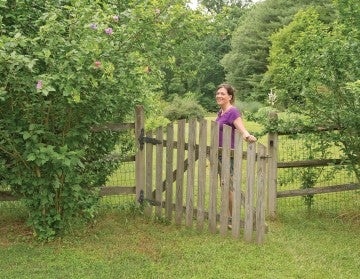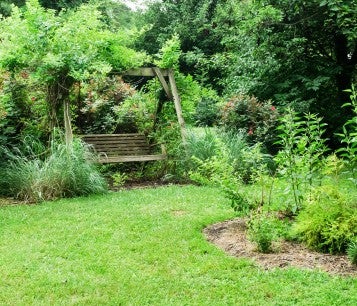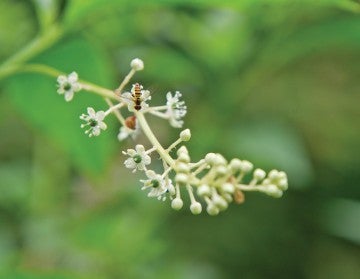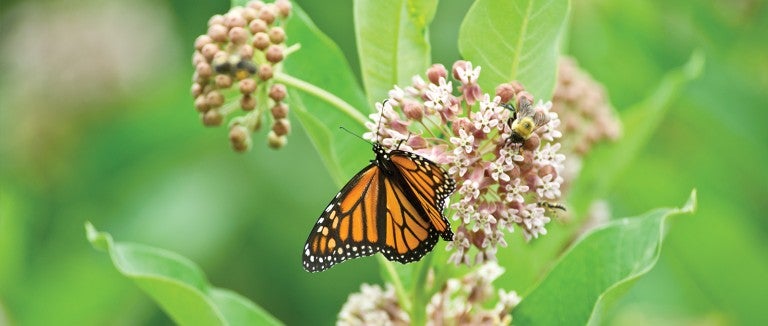The suspect creeping up near my front fence was a tough character—broad-leafed and thick-stemmed and threatening to invade my property and swallow it whole if I didn’t act fast. There was no hesitation that summer morning as I headed to work: Off with his head!
It was a decision made all too easy by the presence of my power-trimmer-wielding husband. I rolled down the window long enough to issue the verdict, “Can you weed-whack that thing while you’re at it?”
Less than 20 minutes passed before a roadside sighting of the same species in bloom alerted me to my error and prompted a phoned-in stay of execution. But it was too late. I had casually ordered the ritual decapitation of a plant that, had I only let it, would soon host hundreds of animals: the beautiful but unfortunately named common milkweed.
As an amateur native plant enthusiast and animal lover with a dog-eared book on the ecology of the Chesapeake Bay watershed, I should have known better. I had grown the related orange butterfly weed species from seed in the basement of my Sykesville, Md., home and had often proselytized about the monarch butterfly’s dependence on this family of plants for her survival.
It was an innocent mistake but one I regretted that whole summer. A child of suburbia, I had not entirely escaped the pervasive myth that seas of invasive turfgrass at our feet are as necessary as the roofs over our heads, rarely stopping to realize how many other species’ homes our national obsession is thoughtlessly and pointlessly taking away.

To be fair, it’s hard for most of us to avoid the mass-marketing tentacles of a multibillion-dollar industry. Fostering an attitude of suspicion—even downright vengeance—toward the natural world is big business. To cultivate 40 to 50 million acres of turfgrass, each year Americans apply tens of millions of pounds of pesticides, killing the insects that birds eat and sometimes the birds themselves, when they mistake granules for seeds, consume contaminated water or food sources or are otherwise exposed. In my state alone, the Chesapeake Bay chokes on runoff from an estimated 86 million pounds of fertilizer spread annually on grass. And 30 % of the U.S. water supply is used outdoors, mostly for lawns; in some areas the figure is as high as 60 %.
After applying all those resources and toxins to making our grass grow, we cut it down, emitting as much pollution per hour of mowing as a car on a 45-mile trip.
A humane backyard is a natural habitat offering wildlife plenty of food, water and cover, plus a safe place to live free from pesticides, chemicals, free-roaming pets, inhumane practices and other threats. And it's so easy to build!

The quest for lawns as pristine as living room carpets extends well past a war on so-called weeds to the attempted annihilation of animals forming the foundation of our ecosystem. One typical garden product commercial I stumbled across begins by detailing insects’ crimes against humanity, scaring homeowners with tales of dire diseases wrought by backyard bugs. In a “you’ve-got-to-be-kidding” moment, the narrator then issues a feverish warning about the presence of birds: It means you have grubs in your lawn that (heaven forbid!) are feeding wildlife.
The recommended solution, though, is no laughing matter. All that hype is lead-up to the advertiser’s real point: Purchase this pesticide and kill all surface insects in 24 hours. Kill the ones underground for up to three months. And that’s just one product. Add up the poisons of a culture hell-bent on maintaining largely lifeless lawns and isolated tree specimens and the results are sobering: During a two-week span in June alone, Florida officials declared two subspecies of butterflies likely extinct, probably due to habitat loss and pesticides, and tens of thousands of bees tumbled to their deaths from trees sprayed with pesticides in an Oregon parking lot.
The public outcry was swift, as it often is for charismatic creatures. But what about the ones with less bling on their wings? Animal lovers who don’t give them much thought have reasons to reconsider. Among the many, here are two that floored me: Along with spiders and other arthropods, about 96 % of this continent’s terrestrial bird species rely on insects to feed their young; birds like chickadees need up to 9,100 caterpillars to feed one brood, says entomologist Douglas Tallamy. “A land without insects,” he writes in his groundbreaking book, Bringing Nature Home, “is a land without most forms of higher life.”

But all is not lost—not yet. By replacing ubiquitous petunias and forsythia with the vegetation our backyard friends co-evolved with for millennia, we can sustain the food chain from the ground up. Tallamy’s research has revealed that suburban yards with native plants are far more likely to attract insects and the birds who feed on them than yards filled with nonnatives; one study found the difference in caterpillar biomass to be 35 times higher.
I’d started reading Tallamy’s writings about the “unprecedented importance of suburban gardens for the preservation of wildlife” during the season my husband and I spotted our first indigo bunting outside the front window, one of many welcome signs our 12-year labor of love was fulfilling its intended purpose. Bluebirds had already made their way here each spring for several years. As I write, spicebush swallowtail caterpillars are rolling themselves up for the day in the leaves of our sassafras grove, where toads sing about impending rain. A few weeks ago a pot on my deck was filled with the tents of American lady butterfly caterpillars. And after the milkweed dared to appear again the next summer, it grew into a mini-forest that now stops once-puzzled neighbors in their tracks.
Of course, I’ve done things I’d prefer to forget. In my early gardening years, I sprayed hollyhocks with an organic solution to “save” them from sawfly caterpillars, only to learn later of the insects’ importance to birds. I once hosed yellow eggs off echinacea leaves before realizing that I’d killed baby ladybugs.
Too often we destroy what we don’t understand, using outsized tools to cut, burn, poison, and tear things out by their roots. Creating a humane backyard starts with using our brains and hearts instead. The path to our reductive grass-scapes was not planted with ill intentions; it’s unlikely that anyone set out to destroy ecosystems. But to restore balance, we need to act with purpose, starting at our back doors, whether they lead to a balcony or, like Loret Setters’ in Florida, to a half-acre wildlife garden outside a mobile home, or whether they open out onto the California desert like Rob Moore’s or at the foot of the Rockies like Mimi and Larry Elmore’s.
We are all part of nature and we have an obligation as the dominant species to do what we can for other animals.

Top five reasons to have a humane backyard
Food, shelter, water, freedom from being sprayed with toxins and mowed down—it’s what we all want, right? Here’s why you should help other species live the American dream:
1. The squirrel by your lamppost isn't planning to grill you for dinner.
Our desire for short-grass landscapes is thought to have originated on the African savannahs, where we needed a long lookout for danger. Here’s a reason to get over our ancient selves: We are now the predators, and the only danger a winterberry holly hedge will shield us from is the mailman (don’t tell the dog). For animals, the risks of our lawn obsession are far greater; negative impacts of turfgrass on wildlife are second only to those of roads.
2. You can run your own Bee & Bee.
If you dream of being an ancient Roman sprawling on his bed with a vessel of wine and a pan of honeycake, you can live vicariously through gentle bumblebees. When it’s time to hit the sack, they crawl beneath bee balm flowers or other favorite watering holes to hang upside down all night. But to witness their antics in the future, we need to provide more habitat. Two species of native bumblebees are already close to extinction—bad news for all of us, since 85 % of the world’s flowering plants (including many that feed us) are pollinated by animals, most of them bees.
3. Your nightlife will sparkle.
Keep an unmowed patch or add native grasses as you convert your landscape, and you may be rewarded with a magical light show. Natural grassy habitats are a favorite hangout of fireflies and other insects such as grasshoppers, an important food source for birds and small mammals. But their life cycles are often thwarted by mowing and chemicals.
4. You'll be popular with eccentric foodies.
Just as monarchs must lay eggs on milkweed, most other insects are also specialists, able to digest chemical compounds found only in certain native plants with which they’ve co-evolved. Growing indigenous plants supports their survival, along with that of the birds and other animals who eat them.
5. You can be lazy and cheap.
Birds are the best gardeners; the more natives you give, the more you get back in the form of surprise seeds they’ve gathered from journeys beyond your yard. Unlike their temperamental foreign cousins, native plants need little care. Plus, you have a great excuse for minimal fall “cleanup”; the less you cut down, the more seeds you leave to sustain animal friends through the dark days of winter.
Want more content like this?
This was written and produced by the team behind All Animals, our award-winning magazine. Each issue is packed with inspiring stories about how we are changing the world for animals together.
Learn MoreSubscribe
